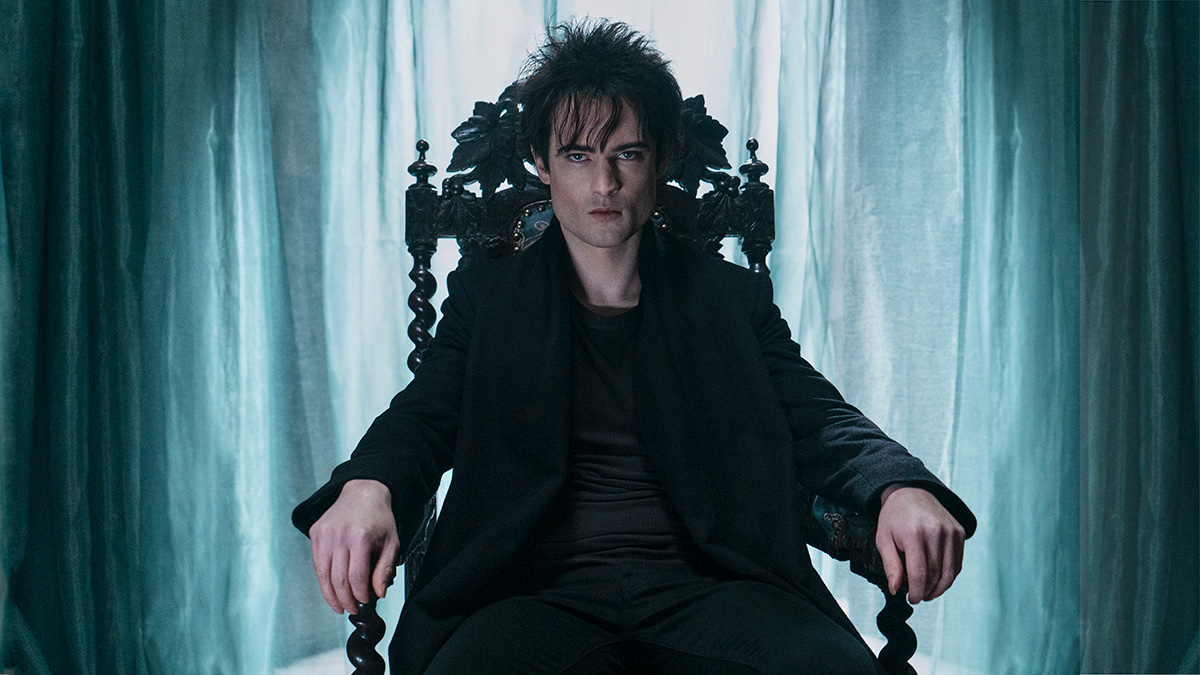How Netflix’s The Sandman Brings the Neil Gaiman Masterpiece to Life
Neil Gaiman and David S. Goyer walks us through the making of Netflix's adaptation of iconic DC comic book series The Sandman.

This article is presented by: 
“Tug of Love Baby Eaten By Cows.” That is the headline of the September 14, 1988 issue of The Sun newspaper in The Sandman story “Preludes and Nocturnes.” The headline is a portent, one of many, hinting that Morpheus, the King of Dreams, has escaped his imprisonment.
The headline was also a kind of portent for the comic’s writer, Neil Gaiman, many years later.
“I didn’t, on a gut level, believe that it was all happening until I was being shown around the prop room,” Gaiman says. “I was walking around the props and being shown stuff, and there in front of me was the copy of a Sun newspaper dated September 2022, and ‘Tug of Love Baby Eaten by Cows’ was the headline. I thought, ‘It’s actually happening, and it’s real, and it’s being made by people who care and who love the original.’”
This passion for the comic is one that can be seen in every aspect of The Sandman’s production.
“You started to feel like every Sandman fan in the movie and TV world who had heard this was happening had begged, cajoled, murdered if necessary, to get onto that set and to be there making [this show],” Gaiman says.
It is not hard to see why the show has evoked such passion. The Sandman comic is one of the most iconic series in the medium’s history, and it played a pivotal role in the perception of comics as a serious storytelling form.
“Like a lot of people at the time, I picked up the first issue of The Sandman as it was published,” says David S. Goyer, one of The Sandman’s executive producers. In the wake of Alan Moore making a big splash on Swamp Thing and Watchmen, a lot of people were saying that Neil Gaiman was the next big thing from the British invasion.
“I loved the first issue, didn’t know what to expect, and just like the rest of the world, it was obvious that a major new voice had arrived on the scene,” Goyer says.
The series follows Morpheus, one of the immortal Endless and the personification of the concept of dreaming, as he escapes from captivity and regains his power. But that is only a prologue to a far broader and stranger story.
“It was interesting because Neil was finding his way as a writer, and this was in the early days of Vertigo Comics. DC and Neil were experimenting with how dark you could go or how much of a mature reader’s book it could be,” Goyer recalls. “I think as the book began, increasingly, it had fewer and fewer touch points to the DC Universe and became more of its own thing. So, I’ve just been a fan ever since. Like a lot of people, I started reading Neil’s novels and eventually became a friend and hoped that I could one day be involved in an adaptation.”
“The Smell Test”
It is an adaptation a lot of people have wanted to see for a very long time, but one of the reasons we haven’t seen it yet is Gaiman himself.
“I’ve now spent literally 32 years making bad adaptations of Sandman not happen,” Gaiman tells us. “And, sometimes, that took a lot of work to stop versions of Sandman, normally as movies, not happening. I always kept myself distanced from Sandman adaptations, partly because if they were going to be terrible, I needed to reserve for myself the ability to go out into the world and say, ‘No, no, no. Don’t watch this. This is terrible.’ I wanted to keep that as a superpower.”
But times have changed, the world has changed, and Neil Gaiman has changed. He is no longer an up-and-coming comics writer, but a successful author, screenwriter, and producer, with the Good Omens TV adaptation demonstrating he is someone to take seriously in the industry.
At the same time, the wildly diverse and often downright otherworldly settings and inhabitants of the comic’s world are now far more achievable to portray onscreen.
“We got very lucky,” Gaiman says. “David Goyer and I had started talking about how we could do it and make it happen. And [writer/showrunner] Allan Heinberg, who had not been free or available, became free. His contract was up with somebody else. We had dinner, more or less, the day after he became free. And he turned up with a Sandman page from ‘Brief Lives’ that he had bought in 1996-ish from a gallery in New York. Lord knows how much that will be worth now.”
Going from deciding to make a TV series to making one is a famously laborious process, but in this one instance, the stars seemed to align. Gaiman and Goyer had dinner with Heinberg on a Friday night, and by Monday morning, the contracts were signed, and the project was being pitched around. It was soon snapped up by Netflix.
Then came the work of actually creating the good Sandman adaptation Gaiman had fought off so many bad versions to bring about.
“One of the things that Neil will often say is, ‘Does it pass the Sandman smell test?’ We’ve changed things. We’ve made adaptations, but it still has to feel Sandman,” says Goyer.
Heinberg also felt a great deal of responsibility approaching the work, especially under Gaiman’s oversight. “This is his baby, and I’ve worshipped since it was born, as a fan,” Heinberg says. “I knew that Neil was executive producing it, and I wasn’t sure how this was going to go because, in television, you have to make a million decisions, and make them immediately. But very organically we discovered that the things we found the most important about Sandman, and the reason to tell the story, were the same.”
A Sandman Masterclass
If that sounds like a quality that is difficult to pin down, it’s because it is. When Goyer attempts to describe it, he points to elements of high fantasy, elements of fable, but also elements of soap opera.
“Our partners kept saying, ‘Can you distill Sandman down into a single sentence or two?’ And we ultimately did figure out a sentence or two,” Goyer tells us. “The first way to look at the show is, it’s a story about a god who, over the course of the story, sheds his godhood and becomes mortal and learns what it means to be mortal.”
While that sounds very lofty and metaphysical, Goyer also points out: “It’s also a melodrama. It’s a story about a really fucked-up dysfunctional family. The Endless, even though they are godlike beings, they all have their petty squabbles. Some of them hate each other. Some of them love each other. It’s just that when they have fights, entire worlds and universes suffer.”
Gaiman has naturally always been protective of The Sandman, but once the adaptation was going ahead, he became an invaluable resource for the writers. “I feel like we got really lucky. I had full reign to do whatever I needed to do or wanted to do on a day-to-day basis. And he knew that there weren’t any decisions that I was making, moment to moment, that I wasn’t sharing with him,” Heinberg tells us. “We were emailing a million times a day and we would Zoom a minimum of three or four times a week. We would talk on the phone, usually, for long stretches on the weekends, and he’s watching everything, and he’s seeing every costume and prop.”
For Gaiman, it was a process that revealed just how much Sandman knowledge he had been carrying around all this time.
“The weird and wonderful thing about talking with Allan about Sandman was realizing that I know more about Sandman than anybody else does and that I could answer his questions,” Gaiman agrees. “I would just tell him everything I knew because it was important, if he was going to be there making day-by-day decisions, that he understood as much as I did. It meant that Allan was getting this sort of weird masterclass in Sandman.”
Over the course of adapting the comics to the screen, some stories have been expanded, and others were fused together, but the end result is one that Goyer believes is faithful to the source material. “I think fans are going to be shocked at how faithful it is,” he says.
A Dream Whose Time Has Come
In many ways, it is the perfect time for an adaptation of The Sandman. TV has just been through a period of long, novelistic series with storylines that progress over multiple seasons, from Game of Thrones to Breaking Bad, to Goyer’s own Foundation adaptation. More recently, the pendulum seems to have swung the other way, toward anthology series such as Black Mirror, Love, Death & Robots, and Jordan Peele’s revival of The Twilight Zone.
But The Sandman, in its original comic series form and the Netflix adaptation, straddles and bounces between both forms of storytelling.
“One of the things that’s wonderful about Sandman is all the standalone issues,” Goyer says. “The stories that sometimes didn’t even necessarily involve Morpheus, but took place in that world. And we were determined to also adapt those stories, to not leave them out in the cold.”
This hybrid of serialized and anthology-style storytelling is reflected in Morpheus, and the question, is he the protagonist of his own story?
“Sometimes he’s the protagonist and sometimes he’s the catalyst,” Goyer argues, pointing to the story in Volume 2 of The Sandman comics, “The Doll’s House.” “I would argue that Rose is the protagonist of that particular story. And ultimately, I think he’s the protagonist of the sort of uber story. Sometimes he is the host in a kind of [The Twilight Zone writer/presenter] Rod Serling-esque way.”
As much as the audience might root for Morpheus, he can also be terrifying in how powerful and distant from humanity he can be.
“He also cares about humanity in the abstract, but not in the specific,” Goyer says. “Which is interesting as well, because when you meet Death in the book and in our show, Death is a much more sympathetic character.”
Another reason why now might be the perfect time for an adaptation of The Sandman is that for many people, the last few years have taken on a dreamlike, unreal quality as the world was put on pause during the Covid lockdown.
“It felt incredibly apt,” Gaiman says. “It felt appropriate, especially with the Sleeping Sickness, the real disease that did start as a sort of peculiar epidemic in 1916, of people just falling asleep and not waking up.”
The Sleeping Sickness epidemic plays an important role in the opening of Morpheus’ story, but making The Sandman during lockdown had an unreality of its own.
“We got to create some incredibly dreamlike moments because we were shooting during a pandemic,” Gaiman remembers. “Probably, the most dreamlike for me is episode three. We filmed it in London and we shot it during that period of lockdown in November 2020, when nobody was allowed to leave their houses. But if you were a film crew, you were considered a vital thing and you were allowed to work.”
The lockdown meant filming in central London with no background artists or extras. Watching the episode, it’s as if the only three human beings in London, as far as you can tell, are Morpheus, Johanna Constantine, and Mad Hettie—as well as Matthew the Raven. “It creates a sort of feeling as if you are in a waking dream, because you’ve never seen that (version of) London. That London doesn’t exist,” Gaiman says. “And yet, that was the London we were able to shoot in.”
Beyond the Comics
As Goyer says, from the outset the Netflix series set out to be as faithful as possible to the original Sandman comics run—but that isn’t the same thing as being beholden to it.
“Neil and David and I got together at Neil’s house in upstate New York, and Neil and David had already discussed a lot of really smart changes,” explains Heinberg. “One of which was doing Johanna Constantine instead of John Constantine; one was making Lucien, Lucienne. And then, early on, I believe that it was David who said, ‘We should have The Corinthian in the very first episode.’”
Doctor Who’s Jenna Coleman is a particularly surprising choice to play Johanna Constantine, in what was originally a John Constantine story.
“We were imagining someone that was more of a hot mess, sort of like John was in the books. Whether it be Sid Vicious or Johnny Rotten or Sting or something like that. But then Jenna’s name came up and it was absolutely right,” Goyer recalls. “You have an [initial] idea in your head of how a character should sound and then you start casting in a certain direction. But then an actor comes in and takes it in a completely different direction.”
The Sandman has drawn together a star cast, but beyond Tom Sturridge as Morpheus, the actors have been chosen for reasons beyond their physical resemblance to the look of the characters in the comic.
“One of the things that’s also challenging and wonderful about Sandman is that it has a singular author, but it has multiple artists,” says Goyer. “So, multiple artists have done depictions of Lucifer, or Morpheus for that matter, so part of our challenge was trying to figure out, well, what was the singular version? Which version did we feel was sort of the platonic ideal?”
The casting process involved internal conversations, pinning down each character to one or two defining sentences and picking actors that represented them. It was a process whereby the showrunners would often surprise themselves. Gwendoline Christie (Star Wars, Game of Thrones) was originally brought in for another role, but asked to read for Lucifer, and got the part.
Casting is not the only change, however. In the comics, the rogue nightmare, The Corinthian, doesn’t appear until “The Doll’s House” arc—the second volume of the series. But the TV show introduces him in the first episode. This decision helped the writers realize how much untold Sandman there was to show.
“There is a lot of stuff happening off-panel that we just didn’t have pages for when the book was coming out monthly,” says Heinberg. “And Neil allowed us not only to imagine what happens between panels or off-page, but he was contributing, from the very beginning, just pitching, ‘What if? What if? What if?’ There was never a defensive pose with Neil in any way.”
It meant that the show could do things that the comics not only didn’t, but couldn’t.
“In “The Doll’s House,” John Cameron Mitchell plays Hal. In the comic, you don’t see Hal performing or singing,” Gaiman says. “Hal comes on and talks to us about the show that he’s in, but we don’t see any performances because we don’t need to and because, honestly, comics are great for a lot of things, but the performances of songs tend not to be one of them. Here, we have John Cameron Mitchell, and we can put him up on a stage with a piano and let him rip and we can make theatrical magic.”
Work on writing a second season of The Sandman has already begun, although whether it will be made still hinges on the performance of the first series. But the show’s ambition has only grown.
“In some ways, it’s easier because we’ve educated the audience to the basic ideas. We’ve shown how the dreaming life can affect the waking world,” Goyer says.With that groundwork done, the show can now build on those themes.
“They’re more like jazz, where you get to plan variations,” Goyer continues. “And we get to stretch our wings a bit more.”
The Sandman premieres on Netflix on Aug. 5.
